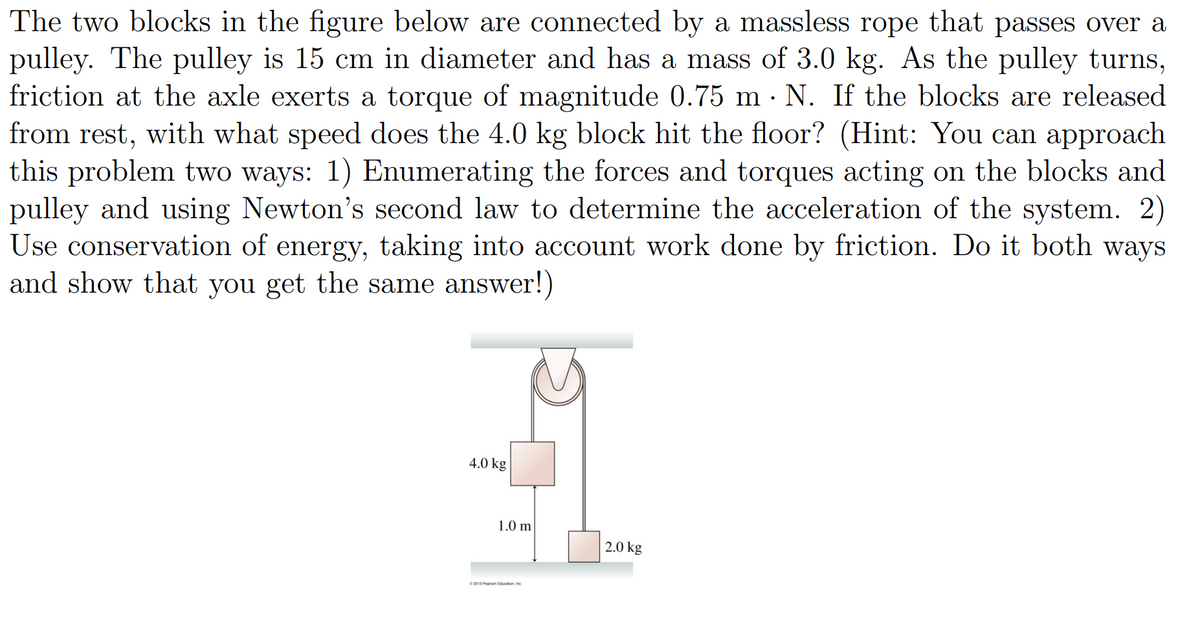The two blocks in the figure below are connected by a massless rope that passes over a pulley. The pulley is 15 cm in diameter and has a mass of 3.0 kg. As the pulley turns, friction at the axle exerts a torque of magnitude 0.75 m N. If the blocks are released from rest, with what speed does the 4.0 kg block hit the floor? (Hint: You can approach this problem two ways: 1) Enumerating the forces and torques acting on the blocks and pulley and using Newton's second law to determine the acceleration of the system. 2) Use conservation of energy, taking into account work done by friction. Do it both ways and show that you get the same answer!) 4.0 kg 1.0 m 2.0 kg
The two blocks in the figure below are connected by a massless rope that passes over a pulley. The pulley is 15 cm in diameter and has a mass of 3.0 kg. As the pulley turns, friction at the axle exerts a torque of magnitude 0.75 m N. If the blocks are released from rest, with what speed does the 4.0 kg block hit the floor? (Hint: You can approach this problem two ways: 1) Enumerating the forces and torques acting on the blocks and pulley and using Newton's second law to determine the acceleration of the system. 2) Use conservation of energy, taking into account work done by friction. Do it both ways and show that you get the same answer!) 4.0 kg 1.0 m 2.0 kg
University Physics Volume 1
18th Edition
ISBN:9781938168277
Author:William Moebs, Samuel J. Ling, Jeff Sanny
Publisher:William Moebs, Samuel J. Ling, Jeff Sanny
Chapter11: Angular Momentum
Section: Chapter Questions
Problem 54P: A cylinder with rotational inertia I1=2.0kgm2 rotates clockwise about a vertical axis through its...
Related questions
Question
100%

Transcribed Image Text:The two blocks in the figure below are connected by a massless rope that passes over a
pulley. The pulley is 15 cm in diameter and has a mass of 3.0 kg. As the pulley turns,
friction at the axle exerts a torque of magnitude 0.75 m · N. If the blocks are released
from rest, with what speed does the 4.0 kg block hit the floor? (Hint: You can approach
this problem two ways: 1) Enumerating the forces and torques acting on the blocks and
pulley and using Newton's second law to determine the acceleration of the system. 2)
Use conservation of energy, taking into account work done by friction. Do it both ways
and show that you get the same answer!)
4.0 kg
1.0 m
2013 Pearson Education, Inc.
2.0 kg
Expert Solution
This question has been solved!
Explore an expertly crafted, step-by-step solution for a thorough understanding of key concepts.
Step by step
Solved in 4 steps with 4 images

Knowledge Booster
Learn more about
Need a deep-dive on the concept behind this application? Look no further. Learn more about this topic, physics and related others by exploring similar questions and additional content below.Recommended textbooks for you

University Physics Volume 1
Physics
ISBN:
9781938168277
Author:
William Moebs, Samuel J. Ling, Jeff Sanny
Publisher:
OpenStax - Rice University

Principles of Physics: A Calculus-Based Text
Physics
ISBN:
9781133104261
Author:
Raymond A. Serway, John W. Jewett
Publisher:
Cengage Learning

Glencoe Physics: Principles and Problems, Student…
Physics
ISBN:
9780078807213
Author:
Paul W. Zitzewitz
Publisher:
Glencoe/McGraw-Hill

University Physics Volume 1
Physics
ISBN:
9781938168277
Author:
William Moebs, Samuel J. Ling, Jeff Sanny
Publisher:
OpenStax - Rice University

Principles of Physics: A Calculus-Based Text
Physics
ISBN:
9781133104261
Author:
Raymond A. Serway, John W. Jewett
Publisher:
Cengage Learning

Glencoe Physics: Principles and Problems, Student…
Physics
ISBN:
9780078807213
Author:
Paul W. Zitzewitz
Publisher:
Glencoe/McGraw-Hill

Physics for Scientists and Engineers: Foundations…
Physics
ISBN:
9781133939146
Author:
Katz, Debora M.
Publisher:
Cengage Learning

College Physics
Physics
ISBN:
9781285737027
Author:
Raymond A. Serway, Chris Vuille
Publisher:
Cengage Learning

College Physics
Physics
ISBN:
9781305952300
Author:
Raymond A. Serway, Chris Vuille
Publisher:
Cengage Learning